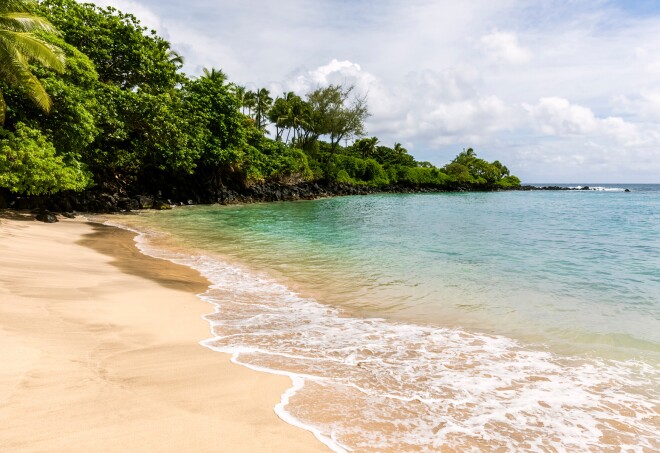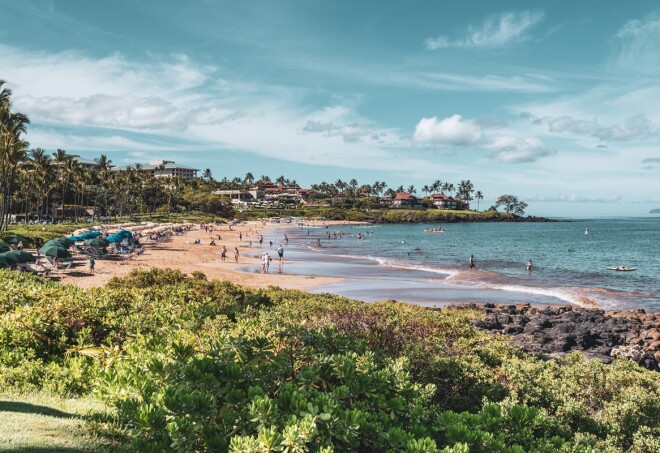Overview
When’s the best time to go to Maui?
Crowds flock to Maui when temperatures cool elsewhere, creating a high season from mid-December to mid-April. However, spring and fall tend to have more consistently great weather, as well as cheaper rates. Avoid visiting during Japan’s Golden Week—from late April to early May—when an influx of visitors from Japan means hotels, restaurants, rental cars, and interisland flights can be hard to come by.
How to get around Maui
Travelers flying from the continental U.S. or overseas will arrive through Maui’s main airport, Kahului (OGG). Both West Maui (JHM) and Hana (HNM) have smaller airfields, but they’re only serviced by interisland airline Mokulele. Once in Maui, rental cars remain the best way to get around, but rideshare companies like Lyft and Uber do operate on the island.
Food and drink to try in Maui
In 1991, a handful of chefs established Hawaii Regional Cuisine, a culinary movement highlighting the archipelago’s local flavors. Featured prominently in many of Maui’s top restaurants, the style of cooking draws heavily on island ingredients like seafood, plus the fruits, vegetables, and cattle that flourish in Upcountry. Popular dishes include poi (ground taro root), kalua pork (slow roasted in an underground oven called an imu), and haupia (a coconut milk custard).
Other must-try local eats include Spam musubi (essentially grilled Spam sushi), loco moco (rice topped with a hamburger patty, fried egg, and gravy), and malasada (a fried doughnut originally from Portugal). If you like spice, season your savory dishes with Hawaiian chili pepper water—or make like the locals and sip the garlicky liquid as a digestive aid.
Culture in Maui
Known for their warmth and emphasis on cooperation, the people of Maui have no dominant ethnicity except “mixed.” Their genes—and culture—blend European, American, Japanese, Filipino, Chinese, Korean, African, Puerto Rican, and Native Hawaiian ancestry, resulting in a laid-back population filled with the aloha spirit. On Maui, you’re more likely to get a friendly shaka hand sign than be cut off in traffic.
Areas like Kihei, Lahaina, Wailuku, and Maui’s neighboring island of Lanai are home to thriving art and food scenes, while in Upcountry, on the slopes of Haleakala, the paniolo (Hawaiian cowboy) town of Makawao attracts visitors with eclectic boutiques, restaurants, and Hawaii’s most historic bakery. When visiting the island, you’ll also want to catch some hula and Hawaiian music, which goes far beyond traditional ukulele melodies to reggae and even rock. Other can’t-miss events include the prestigious Maui Film Festival, the Kapalua Wine & Food Festival, and the OluKai Ho‘olaule‘a paddling race, all in June.
Can’t miss things to do in Maui
It’s impossible to see all that Maui has to offer in just one visit, but visitors shouldn’t miss snorkeling in the extinct volcanic crater of Molokini, driving the twisting Road to Hana, and watching the sunrise from the top of Haleakala. Of course, a visit here also wouldn’t be complete without some beach time at popular spots like Kapalua, Wailea, Kāʻanapali, Hamoa, and Ho’okipa. For those with more time, towns like Paia, Makawao, and the picturesque former whaling village of Lahaina boast some excellent shopping and dining.
Practical Information
As a state, Hawaii doesn’t require passports or visas for travelers from the contiguous U.S., Alaska, and territories like Guam. Locals speak English, enlivened by Hawaiian pidgin. Expect to hear phrases like “slippahs” for flip-flops and “talk story” for shooting the breeze. The Native Hawaiian language is also enjoying a renaissance and features in everyday conversations across the island. Essentials include aloha (hello and goodbye), mahalo (thank you) and pūpūs (appetizers), plus the navigation essentials makai (toward the sea) and mauka (toward the mountains).
Like the rest of America, Maui has 120V electricity and uses type A and B outlets. Travelers should also know that the island’s warm welcome extends to all visitors, including the LGBTQIA community.
Local Resources
- Hawaii Beach Safety: Don’t even walk on the beach—let alone hit the water—without consulting this site.
- Frolic Hawaii: A local entertainment and lifestyle site.
- MauiTime: A locally owned independent newspaper.
- Hawaii Revealed: A site by the island’s top guidebook writer, Andrew Doughty
Guide Editor
A former wilderness guide, Amanda Castleman is also a travel writer and photographer who’s happiest covering nature, animals, and outdoor adventures. Her article on scuba diving in Honduras won a Lowell Thomas award.






